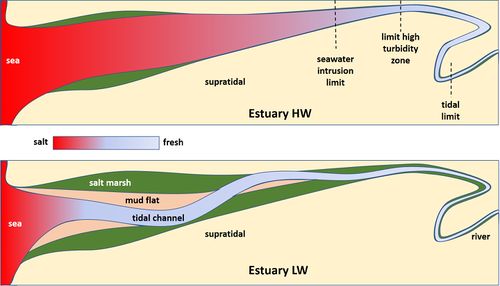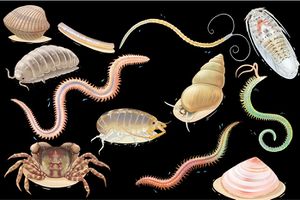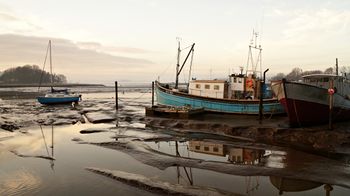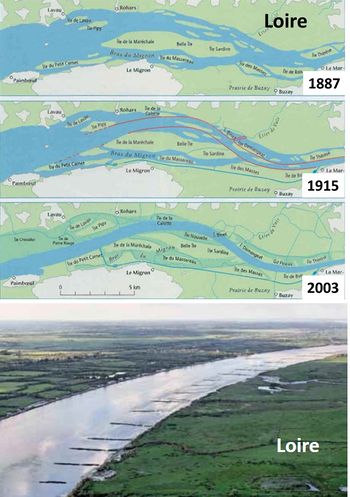Estuarine ecosystems
What is an estuary? Many different definitions can be found in the scientific literature. Three important characteristics are: estuaries are physically confined, estuarine waters are a mix of seawater and freshwater, and estuaries are a habitat for species that are naturally tolerant to stresses caused by temporal and spatial variations in salinity, temperature, dissolved oxygen (DO), turbidity, and bottom sediment. Estuarine ecosystems are therefore relatively poor in species diversity, but these species can be very abundant. They provide a wealth of food and ecosystems which support fish, birds, and other wildlife and contribute significantly to the quality of life for humanity. Estuaries are said to be among the most productive natural habitats on earth.
Contents
Description
Estuaries represent the transition between freshwater and marine environments and are influenced by both aquatic realms. They are referred to as 'transitional waters' in European legislation[1]. Salinity levels are indicative of the position within the mixing zones of an estuary. The upper limit of an estuary is referred to as its head, while the lower limit is called the mouth of the estuary. Between the freshwater head and the saline mouth of the estuary lie several zones corresponding to intermediate salinity ranges (Fig. 1). These zones also differ in other respects, such as light penetration and the type of substrate, and therefore host different communities of organisms. However, it should be realized that these zones move up and down the estuary with the tide over distances typically on the order of 10 - 20 km. Swimming and floating organisms move with the tide, but benthic organisms do not. They have to cope with tidally modulated salt contents that can vary between oligohaline and mesohaline or between mesohaline and polyhaline. On the time scale from month to season, the variation in salinity is even greater because of variations in river discharge.
| Estuary division | Length scale [km] | Subtidal (channel) substratum | Intertidal (mudflat, saltmarsh) substratum | Salinity range | Zone | Organism type |
|---|---|---|---|---|---|---|
| river | - | gravel / sand | - | < 0.05 | limnetic | freshwater |
| tidal river (seaward of tidal limit) | 10 - 100 | sand | silt / mud | 0.05 - 0.5 | limnetic | freshwater |
| estuary head (seaward of salt intrusion limit) | 2 - 5 | sand / silt | silt / mud | 0.5 - 5 | oligohaline (brackish) | oligohaline, freshwater migrants |
| upper reach | 5 - 25 | sand /silt / mud | silt / mud | 5 - 18 | mesohaline | true estuarine, limit of non-transient migrants |
| middle reach | 5 - 25 | sand / silt / mud | silt / mud | 18 - 25 | polyhaline | estuarine, euryhaline |
| lower reach | 5 - 10 | sand | silt / mud | 25 – 30 | polyhaline | estuarine, euryhaline, marine migrants |
| mouth / sea | 5 - 10 | sand / gravel / rock | - | 30-35 | euhaline | stenohaline, all marine |
Ecosystem services
Estuaries are highly productive systems that provide many essential services:
- Filtering and detoxing water and sediments through microbial degradation
- Biogeochemical cycling, such as denitrification of agricultural effluents (see Nutrient conversion in the marine environment)
- Carbon sequestration in the soil of salt marshes and mangals (see Blue carbon sequestration)
- Physical protection of the coastline through wave dissipation (see Natural shore protecting barriers)
- Feeding, reproduction, and nursery grounds for many species (fish, birds, …).
Despite being a stressful environment, with little apparent complexity, life is abundant on tidal mud and sand flats, in the sediment, on the sediment and above the sediment. High primary production of microphytobenthos on intertidal flats and high secondary production due to macro and meiofauna provides the basis of estuarine food webs.
Two essential estuarine habitats, salt marshes and mangroves, are discussed in the articles Salt marshes and Mangroves.
The challenges of estuarine ecosystems
Organisms that live in estuaries must be adapted to the specific conditions that occur here. The most constraining condition is the varying salinity. Most organisms are so-called stenohalines: they survive only in an environment with a certain more or less constant salinity, for example in the sea or in rivers. These species cannot survive in an estuarine environment. Species that thrive in an estuarine environment must be able to cope with varying osmotic pressures related to varying salinity; these species are called euryhalines. When the internal osmotic pressure of a cell is lower than the external pressure, the cell will lose fluid and shrink; in the opposite case, the cell will swell. There are two strategies to counter this. One strategy is used by the so-called osmoconformers: they regulate the internal osmotic pressure in such a way that it becomes equal to the external osmotic pressure. Depending on the ambient salinity, they achieve this by producing the required amount of organic osmolytes (molecules such as sugars, amino acids, methylamines) to balance the internal and external osmotic pressure[4]. The other strategy is used by the so-called osmoregulators: they regulate the osmotic pressure by secreting an excess of salt or an excess of water, depending on the salinity of the environment. Because euryhaline species are relatively rare, the estuarine ecosystem is characterized by a relatively limited biodiversity (Fig. 2) but a high abundance of specific estuarine species.
Most marine invertebrates are osmoconformers and generally stenohaline. However, some species are euryhaline, for example barnacles, some polychaetes worms and some copepods. Bivalve mollusks are euryhaline osmoconformers within a limited salinity range, but cope with strong salinity variations by closing their valves. Marine vertebrates are generally osmoregulators. Several crustacean species (e.g. crabs) and fish species (e.g. salmon, flounder) are euryhaline. Euryhaline osmoregulating vegetation species include Spartina and Salicornia. Mangroves, however, are adapted to specific salinity ranges and thus cannot be classified as euryhaline.
Lowland reaches of rivers are characterised by high levels of suspended solids, such as silt, clay and organic detritus, inducing high turbidity. In the freshwater-seawater transition zone these particles become effectively ‘trapped’ due to flocculation and converging suspended sediment fluxes [5][6]. These convergences result in a so-called estuarine turbidity maximum (ETM). For further explanation, see the articles Estuarine turbidity maximum and Dynamics of mud transport.
Turbidity limits the depth of the photic zone (light penetration zone), thus limiting the photosynthesis and primary production. Much of the primary production in estuaries occurs on the seaward side of the ETM (Swart, 2007[7]). Macrophyte vegetation and benthic algae are often limited to the periodically exposed (intertidal) part of the estuary, while the growth of phytoplankton is restricted to a thin upper layer of the water column (Cloern, 1997[8].) As a result, estuaries are heterotrophic systems, where more energy is consumed than produced. Most estuarine species are detritivores, meeting their energy intake requirements from organic matter contained either in the sediment (deposit feeders), in suspension (filter feeders) or both. Benthic invertebrates play a major role in energy cycling in estuaries (Wilson and Parkes, 1998[9]).
Particulate matter eventually settles in the estuarine mid reaches where the substratum can contain a high mud fraction, especially in the intertidal areas adjacent to the main tidal channels (Fig. 3). These mudflats are less suitable for organisms with an affinity for hard substratum but provide an important habitat for a range of burrowing invertebrate species, of which bivalve mollusks and polychaete worms are usually dominant in terms of numbers and biomass. These in turn provide an attractive dish for higher trophic consumers.
Sediment deposition gradually increases the height of the intertidal areas until submergence only occurs at the highest tides. Accretion is stimulated by the development of vegetation on the landward zones which are most sheltered from currents and waves. These high vegetated zones of the intertidal area, the so-called saltmarshes, form an important estuarine habitat. This habitat is described in the article Salt marshes.
Industrialised and urbanised river catchments and estuaries receive anthropogenic input from various sources (both point sources and diffuse sources) and often carry a range of contaminants. These pollutants bind to fine sediments and therefore can accumulate in sheltered, low-energy areas such as intertidal mudflats in enclosed bays or estuaries. The estuarine benthic fauna of these zones can thus be subject to high contaminant levels (Kausch and Michaelis, 1996[10]). For further details, see: Coastal and marine sediments#Sediment contamination and bioavailability.
Biodiversity of estuarine ecosystems
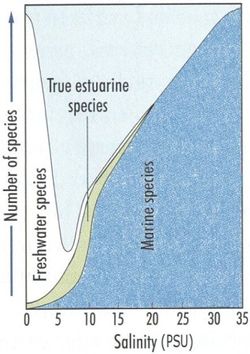
Truly estuarine species are those that complete their whole life cycle within the transitional waters. Species permanently dwelling there are mostly hardy, stress-tolerant species able to handle salinity fluctuations and high suspended solid levels. Organisms living on the higher parts of the mudflats and on the salt marshes are subject to additional stresses during temporary emersion at low tide, such as exposure to air, dehydration and temperature variations. Not many species can perform well under such conditions. Estuarine ecosystems are thus characterised by relatively low species diversity compared to freshwater or full salinity conditions[12]. Along the estuary, from head to mouth, freshwater species become rare as salinity increases and are gradually replaced by marine organisms in the lower estuarine reaches, with some truly estuarine species found at intermediate salinities. This pattern is reflected in the distribution of total species diversity, with the least diverse fauna found at salinities between 5 and 18 ppt (low taxonomic [math]\alpha[/math]-diversity). This is graphically displayed in the so-called Remane curve, see Fig. 4. However, the strong spatial gradients in this curve are indicative of high [math]\beta[/math]-diversity (change in species diversity along environmental gradients) and [math]\gamma[/math]-diversity (regional diversity, see Measurements of biodiversity).
Apart from the permanent dwellers, estuaries are host to a number of visitors. Some of them have to travel through estuaries on their migratory route, being either anadromous (spawn in freshwater and feed and grow at sea) or catadromous (spawn at sea and feed and grow in freshwater). The absence of many of the marine predators and rich particulate food supply offer attractive spawning and nursery grounds for many species that normally live under full salinity conditions. Even though estuarine ecosystems are usually species-poor, species abundance is high and they maintain a high productive throughput of invertebrate fauna. This productivity provides rich feeding opportunities for a range of higher consumers. Some marine predators are well equipped to cope with reduced salinity and frequently enter estuaries in search of food. For example, estuarine fish populations are typically dominated by trophic generalists which create complex foodwebs as each higher predator species feeds on many types of prey[13]. Ebb tide makes estuarine beds available to terrestrial predators, of which birds take the greatest share. Estuarine sand and mudflats that are periodically exposed to air support high densities of a diverse bird fauna. This value of estuaries has been long recognized and many estuarine sand and mudflats have been designated as Special Protection Areas (SPA) under the EU Birds Directive (79/409/EEC).
Threats
Estuarine ecosystems are usually dominated by stress-tolerant organism, able to withstand a wide range of environmental conditions. However, they also have to face serious threats from anthropogenic activities.
- Estuaries are preferred locations for human settlement, especially due to the natural connections they offer between inland and overseas destinations. Residential, recreational and industrial developments (such as harbours or ports and marinas) are usually located right at the waterfront with supporting structures (roads, railways) that cut off the connections with the upper shore habitats. Estuaries are often challenged by land development; land reclamation is particularly detrimental in this respect as it results in a permanent loss of habitat.
- Making estuaries with shifting shoals and channels navigable has long been beyond human capabilities. This changed at the end of the 19th century, when large-scale dredging technology became available. Without exception, all estuaries on which harbors were located, have been channeled in the 20th century (Fig. 5). A deep navigation channel was dredged, often deviating from the natural tidal channel. The channel banks were set in stone and groynes were constructed to concentrate the flow and to suppress the natural tendency of tidal channels to shift and meander. Channel deepening allowed the tide to propagate further up the river (with especially a strong lowering in the low water level) and both salt intrusion and turbidity increased, sometimes to a very large extent (see River tides#River channel deepening). Fixing the channel banks has led to strong sedimentation of the remaining intertidal areas, causing the mud flat and salt marsh levels to rise. The raised salt marshes have often been embanked and turned into agricultural land or have become terrestrial habitats. The dynamics of migrating tidal channels, the natural agent of habitat rejuvenation and new marsh development, has therefore been thwarted and replaced by a development towards aging landscapes with significant loss of biodiversity. See for more details Tidal channel meandering and marsh erosion.
- Rivers discharging into their estuaries carry various constituents depending on the landuse of the drainage area (catchment). This means that various contaminants introduced at any point in the catchment ultimately end up in the estuary. Although estuarine organisms are typically hardy, these pollutants and excess nutrients impede their overall performance (including growth and reproduction). Pollution from densely populated or heavily industralised catchments has detrimental effects on life in estuaries. See: Eutrophication in coastal environments, Coastal pollution and impacts.
- Climate change impacts of concern for estuaries are the overall temperature rise and elevation of the sea level. The former is likely to induce latitudinal migration with more warm-water species being increasingly established and possibly outcompeting the native species in a long run. Sea level rise would result in a shift of the salinity zonation landwards (see also Effects of global climate change on European marine biodiversity). However, coastal areas, including estuaries, are usually heavily populated and developed. In such developed areas the vertical shift of salinity zonation will be hindered by flood defence structures and river and shore embankments resulting in estuarine squeeze. Because many estuaries are situated in lowland, a substantial rise of the high water levels will have great consequences for the safety of the people living in these low-lying areas and for their properties and infrastructure. See the article Coastal cities and sea level rise.
Related articles
- Morphology of estuaries
- Estuarine turbidity maximum
- Salt marshes
- Mangroves
- Blue carbon sequestration
- Seawater intrusion and mixing in estuaries
- Measurements of biodiversity
- Tidal asymmetry and tidal inlet morphodynamics
- Coastal and marine sediments
- Estuarine morphological modelling
- Osmosis
- Other articles in the category Estuaries and tidal rivers
References
- ↑ McLusky, D.S.and Elliott, M. 2007. Transitional waters: a new approach, semantics or just muddying the waters? Estuarine, Coastal and Shelf Science 71: 359-363
- ↑ Carriker, M. R. 1967. Ecology of estuarine benthic invertebrates: a perspective, p. 442-487. In G. H. Lauff (ed.), Estuaries, American Association for the Advancement of Science. Washington.
- ↑ McLusky, D. S. 1989. The Estuarine Ecosystem, 2nd Ed. Chapman & Hall, London.
- ↑ Yancey, P.H. 2005. Organic osmolytes as compatible, metabolic and counteracting cytoprotectants in high osmolarity and other stresses. J. Exp. Biol. 208: 2819–2830
- ↑ Kranck, K. 1981. Particulate matter grain-size characteristics and flocculation in a partially mixed estuary. Sedimentology 28: 107 – 114.
- ↑ Robinson M. C., Morris, K. P. and Dyer, K. R. 1999. Deriving fluxes of suspended particulate matter in the Humber Estuary, UK, using airborne remote sensing. Marine Pollution Bulletin, 37: 155 -163
- ↑ Swart, de H. E., Schuttelaars, H. M. & Talke, S. A. 2007. A simple model for phytoplankton growth in turbid estuaries. Geophysical Research Abstracts 9, 04190
- ↑ Cloern, J.E. 1997. Turbidity as a control on phytoplankton biomass and productivity in estuaries. Continental Shelf Research 7: 1367-1381.
- ↑ Wilson, J.G. and Parkes, A. 1998. Network analysis of the energy flow through the Dublin Bay ecosystem. Biology And Environment: Proceedings Of The Royal Irish Academy 98B (3): 179–190.
- ↑ Kausch, H. and Michaelis, W., eds. 1996. Suspended particulate matter in rivers and estuaries - Proceedings of an International Symposium held at Reinbek near Hamburg, Germany. Advances in Limnology, 47.
- ↑ Remane, A. 1934. Die Brackwasserfauna. Verzeichnis der Veröffentlichungen Goldsteins, 36: 34–74. .
- ↑ Whitfield, A.K. and Elliott, M. 2011. Chapter 1.8: Ecosystem and biotic classifications of estuaries and coasts. In: McLusky, D.S. and Wolanski, E ., eds. Treatise on Estuaries and Coasts. Elsevier, Amsterdam
- ↑ Elliott, M. and Hemingway, K.L., eds. 2002. Fishes in Estuaries. Blackwell Science, Oxford, pp. 636
Please note that others may also have edited the contents of this article.
|
